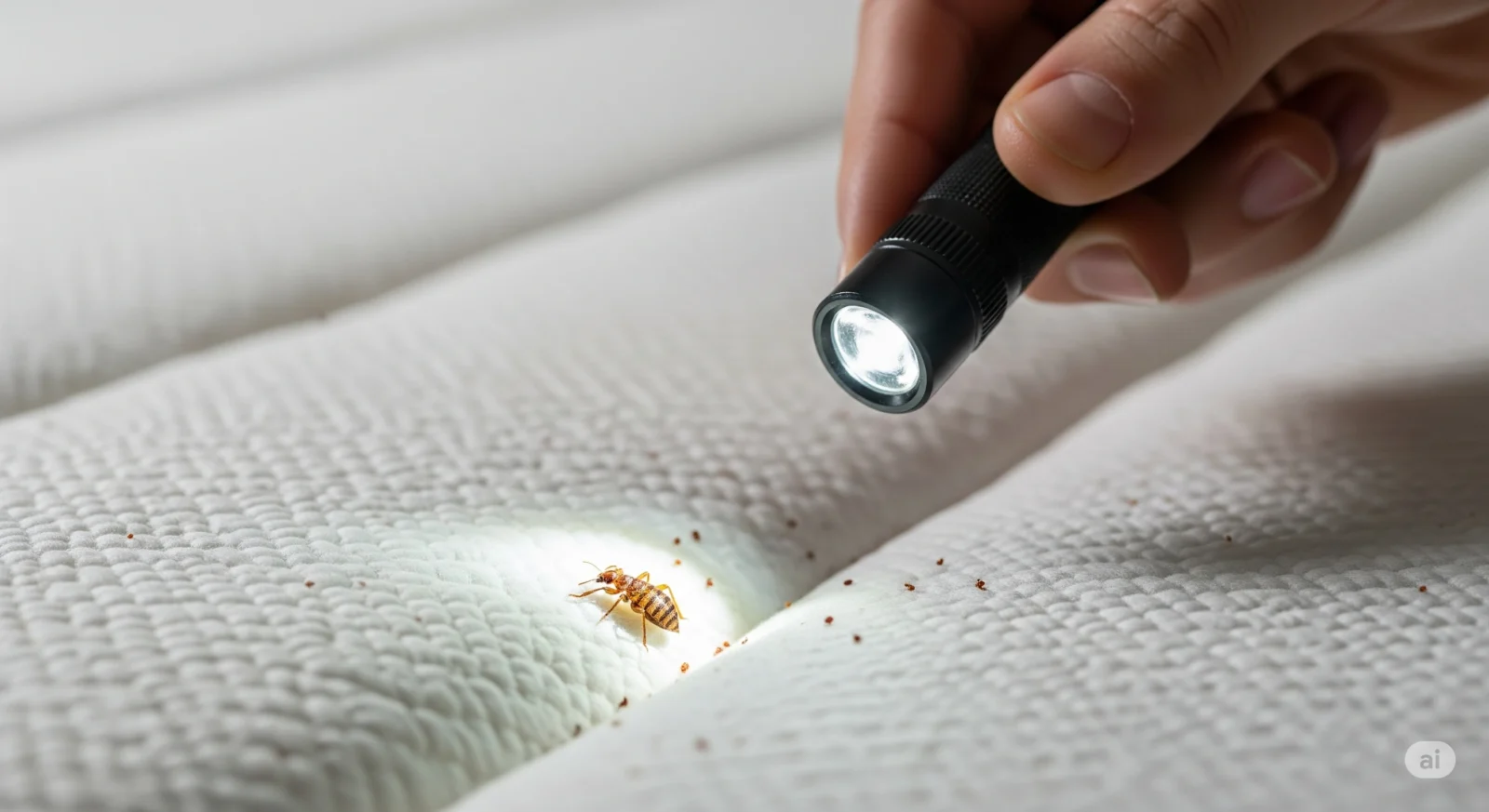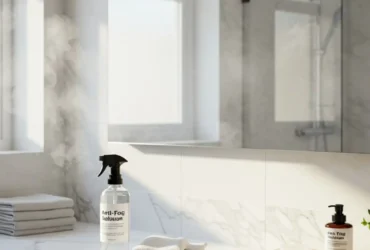That awful, anxious feeling that you might have bed bugs is enough to ruin anyone’s sleep. If you’re waking up with itchy bites or just have a nagging suspicion, you need answers now. This guide is dedicated to teaching you how to check for bed bugs effectively. Knowing the correct process to check for bed bugs is the most critical first step toward reclaiming your bedroom and your peace of mind. We’ll cover everything in simple terms, so you’ll understand exactly how to check for bed bugs like a professional.
“Discovering you need to check for bed bugs is stressful, but it’s manageable. Remember, these pests aren’t a sign of a dirty home. The most important thing is a thorough bed bug inspection. I’ll show you my proven method so you can feel confident in your search.”
My Unwanted Discovery: A Personal Story
I’ll never forget the weeks I spent waking up with strange red welts. I blamed everything from spiders to a new laundry detergent. The constant worry was exhausting. I finally decided I had to learn how to check for bed bugs myself. Armed with a flashlight, I began my own bed bug inspection, and the subtle signs I found along my mattress seams confirmed my fears. That experience was terrible, but it taught me a valuable lesson: having a clear, calm plan is everything. This guide contains the exact steps I wish someone had given me.
Ready to start checking for bed bugs? Let’s begin.
The 5 Essential Steps: Here’s How to Check for Bed Bugs
This section provides the exact process for how to check for bed bugs. Follow these steps carefully to ensure you don’t miss any signs. Being methodical is the key when you check for bed bugs.
Step 1: Get Your Inspection Tools Ready
Before you begin checking for bed bugs, gather these simple items. It makes the whole process easier.
- A powerful flashlight: Essential for seeing into dark crevices.
- A magnifying glass: Helps identify tiny eggs and nymphs.
- A stiff card (like a credit card): Use this to scrape along seams and force out hidden evidence.
- Clear plastic bags: To immediately seal any potentially infested bedding.
Step 2: Prepare and Inspect the Bedding
Your bed is the primary place to check for bed bugs. Start here.
- Gently remove all bedding: Pull back the comforter, blankets, sheets, and pillows one by one.
- Inspect each piece closely: As you remove an item, look for the tell-tale rust-colored spots or black dots that indicate bed bug activity. A thorough bed bug inspection of your linens is crucial.
- Bag any suspicious items: If you find evidence, place the bedding in a sealed plastic bag to prevent spreading the issue before washing.
Step 3: How to Check for Bed Bugs on the Mattress and Box Spring
This is the most critical part of the process. Bed bugs hide close to their food source.
Focus on seams, tufts, and tags: Slowly go over every inch of the mattress. Use your plastic card to check deep inside the seams and piping. This is how you check for bed bugs in their favorite hiding spots.
Know the signs you’re looking for:
- Black Spots: Fecal matter that looks like tiny ink dots.
- Shed Skins: Translucent, bug-shaped casings left behind as nymphs grow.
- Eggs: Tiny (1mm), pearly-white ovals, often found in clusters.
- Rusty Stains: Result from crushed bed bugs.
Don’t forget the box spring: After the mattress, repeat the entire process on the box spring. Check underneath, where the fabric is stapled to the frame, as this is a common refuge.
Step 4: Widen Your Search Area
If an infestation is established, you’ll need to check for bed bugs in the surrounding area too.
- Bed Frame and Headboard: Inspect every joint, crack, and screw hole in the bed frame and headboard.
- Nearby Furniture: Empty and inspect nightstands and dressers.
- Upholstered Items: When you check for bed bugs, don’t forget chairs or couches in the room.
- Walls and Floors: Look behind picture frames and along baseboards.
Step 5: Look for Live Bugs During Your Inspection
While you check for bed bugs, you may find a live one. They are flat, oval, and reddish-brown, about the size of an apple seed. Try to capture one on clear tape for positive identification.
7 Helpful Tips for How to Check for Bed Bugs
- Be Methodical. When you learn how to check for bed bugs, you learn to be systematic. Start at the bed and move outward.
- Inspect Secondhand Items. Always perform a bed bug inspection on used furniture before it enters your home.
- Check Luggage After Travel. Your suitcase is a common carrier. Check for bed bugs in the zippers and seams after a trip.
- Vacuum As You Go. A vacuum can help remove any bugs or eggs you find during your inspection. Dispose of the bag immediately.
- Be Patient. A proper inspection takes time. Rushing is the fastest way to miss something.
- Use Your Nose. A strong, musty, sweet odor can indicate a heavy infestation.
- Take Photos. Documenting what you find helps professionals identify the pest correctly.
Common Mistakes in How to Check for Bed Bugs
- Only Checking the Bed: A huge error. A complete bed bug inspection involves the entire room.
- Using Bug Bombs: These products are ineffective and can make the problem worse by scattering the bugs.
- Thinking No Bites = No Problem: Not everyone reacts to bites. You must rely on physical evidence.
- Ignoring Small Signs: That one tiny spot is a big warning. The key to how to check for bed bugs is taking every sign seriously.
Alternate Inspection Methods
If your DIY approach to how to check for bed bugs is inconclusive, consider these professional options:
- Canine Inspection: Trained dogs can accurately sniff out bed bugs and their eggs.
- Interceptor Traps: These devices go under bed legs and trap bugs, providing undeniable proof.
Troubleshooting Your Guide on How to Check for Bed Bugs
- “…I checked for bed bugs but found nothing. Why am I still getting bites?” The bites could be from other pests like fleas or mites, or it could be a skin condition. Use interceptor traps for a few weeks to be certain.
- “…I found a single bug. Now what?” One bug almost always means more are hiding. It’s time to call a professional. Don’t delay.
- “…I’m not sure if what I found is a bed bug sign.” Compare your findings to photos from authoritative sources like the Environmental Protection Agency (EPA). A professional can also provide a positive ID.
Conclusion: Your Inspection is Complete
Learning how to check for bed bugs is a nerve-wracking but empowering process. You now have the knowledge from this guide on how to check for bed bugs to perform a thorough inspection and identify a problem early. Whether your search came up empty or confirmed your fears, you are now in a position to take confident, informed action. If you want more ‘how-to’ queries answered, visit HowToResults.com for other helpful guides.
FAQs
Here are common questions people have about how to check for bed bugs.
What is the very first sign when you check for bed bugs?
Often, the first physical evidence you’ll find are the tiny, dark fecal spots on mattress seams or sheets. This is often more reliable than bites, as not everyone has a skin reaction.
Can you see bed bugs easily with the naked eye?
Yes, adult bed bugs are visible, but nymphs and eggs are extremely small and hard to see. That’s why a key part of how to check for bed bugs involves using a flashlight and magnifying glass.
Do bed bugs mean my house is dirty?
No, this is a harmful myth. Bed bugs are not attracted to dirt. They are found in pristine homes and luxury hotels. Needing to check for bed bugs is about exposure, not cleanliness.
When is the best time to check for bed bugs?
You can perform an inspection anytime. While the bugs are most active late at night, a thorough daytime search of their hiding spots is the standard way to find evidence.
Is it enough to just check the mattress for bed bugs?
No. A proper bed bug inspection must go beyond the mattress to include the entire bed frame, headboard, and nearby furniture to be considered complete.
How do I check for bed bugs in a hotel room?
Pull back the sheets and inspect the mattress seams and the area behind the headboard before you unpack. Keep your luggage on a metal rack.
What do bed bug droppings look like?
They look like small dots from a black felt-tip pen and will smear with a reddish tint if you wet them.
Will I feel it if a bed bug bites me?
No. Their saliva contains an anesthetic, so you won’t feel the bite as it happens. The itching comes later.
Is it possible for bed bugs to live in your hair?
This is extremely rare and unlikely. Bed bugs are not equipped to live on a human host like lice are.
After I check for bed bugs and find them, can I get rid of them myself?
DIY treatments are very difficult and often fail. Because they are so resilient, professional treatment is the most effective solution to ensure complete eradication.

















Leave a Reply